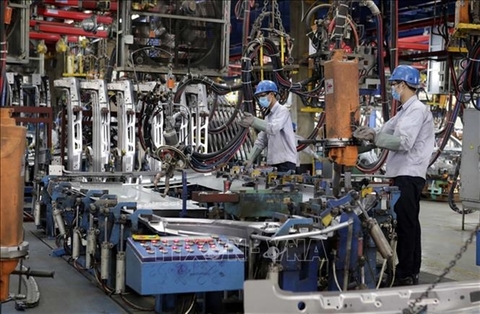Vietnam - a country with 100 million people, with a large, intelligent, hardworking and highly skilled workforce in the region - is a destination for many multinational corporations, with a wide range of activities, from aerospace technology to ships, automobiles to electronics, but the supporting industry is less developed.
First opportunity has passed
 |
|
|
The Vietnam Association of Supporting Industry Enterprises’ data shows that the localization rate supporting industry products of Vietnamese enterprises is quite low.
Specifically, the localization rate for the automotive industry is 5-20%, the electronics industry is 5-10%, the leather, footwear and textile industry is about 30%, the high-tech industry is 1-2%, and other mechanical engineering industries 5-20%. Currently, Vietnam has only about 500 enterprises engaged in supporting industry production, accounting for more than 0.2% of the total of nearly 1 million enterprises.
These are alarming figures compared to the supporting industry in other Southeast Asian countries. For example, Thailand, the auto industry supporting industry has about 2,000 enterprises.
This leads to a limitation on improving the localization rate for products, which are mainly simply assembled, and the annual value of imported components and accessories is very large. By 2021, the value of imported components for the automotive, electronics, agricultural and fishery industries and other mechanical engineering industries was hundreds of billions of USD, including about 50 billion USD/year for imported components for the automotive and electronic industries.
According to Nguyen Hoang, Chairman of the Hanoi Association of Supporting Industry Enterprises, the first opportunity to develop the supporting industry has passed, since Vietnam opened its doors for foreign investment 30 years ago. Vietnam lacks policies to promote the development of supporting industries participation in the supply chain to produce components for foreign-invested enterprises and large foreign corporations. Along with that, it also lacks a mechanism to bind foreign-invested manufacturers to localize their products.
Vietnam has a huge market for supporting industries in the manufacturing sector, which values hundreds of billions of US dollars annually, but this opportunity has been ignored.
Could a second chance be grasped?
Since 2017, Vietnam has always had a total annual import-export turnover twice as high as its GDP. It can be affirmed that Vietnam’s economy has the largest trade openness in the world, 1.5 times higher than that of Thailand and 5 times higher than that of China.
Even in 2020-2021, when it was seriously affected by the Covid pandemic, the total export turnover was maintained at this level. With such a large trade openness but GDP growth not reaching 7.5%/year or more, Vietnam does not benefit much from this. The country mainly imports materials to assemble and then exports. This has been even more obvious at the time of the pandemic, when the GDP growth rate dropped sharply.
Pham Dinh Doan, Chairman of Phu Thai Group, said the Covid pandemic caused a change in the globalization process. Currently, there are four main trends shaping the supply chain: shortening the chain, diversifying the chain, regionalizing the chain and multiplying the chain.
In the current situation, multinational corporations will shorten the value chain to protect themselves from collapse. They also diversified the geographical area to reduce the "shocks" in a specific area, thereby reducing the cost of responding to the crisis. In particular, the trend is to shift supply chains and reduce concentration in one country to reduce risks while transforming long, complex, potentially risky global supply chains into shorter, simpler, more flexible chains.
In that situation, opportunity has opened for Vietnam. Foreign investment inflows are still increasing, despite the pandemic. The proportion of investment capital in the field of processing and manufacturing still accounts for more than half. This is the second chance for Vietnam to develop supporting industries.
To develop the supporting industry, experts say that it is necessary to immediately develop the Law on Supporting Industry as soon as possible and submit it to the National Assembly for promulgation as soon as possible.
It is a must to establish a State-level Steering Committee to solve difficulties for and promote supporting industries; and develop specific plans and roadmaps to develop supporting industry enterprises by 2025 with a vision to 2030, with the goal that supporting-industry businesses to make up 5%-10% of the total number of Vietnamese enterprises.
Other solutions include: making specific planning for each economic region in order to develop supporting industries; designing a special package and specific assistance measures for supporting industries; connecting foreign-invested enterprises with Vietnamese enterprises to participate in the supply chain together; having policies to encourage foreign-invested companies to increase localization; and having preferential policies to encourage people to invest in projects in the field of supporting industries instead of speculating in land and trading securities.
Tran Thuy

Industrial development needs State’s long-term vision
To develop the processing and manufacturing industry, the State needs to have stronger policies that focus on domestic enterprises. To have strong policies, it needs strong resources.

VN to boost domestic 'supporting industries'
Vietnam is looking to work closely with foreign firms such as Samsung and Toyota to boost the supply of parts within the country, according to the Ministry of Industry and Trade.